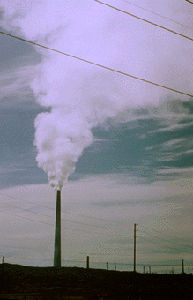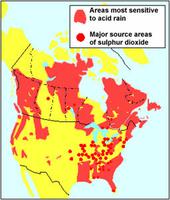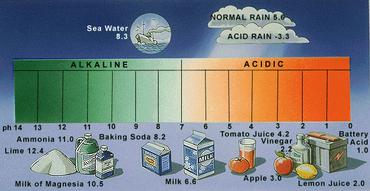Acid Rain
Acid rain is the wet or dry deposition of acidic substances and their precursors on the Earth's surface. The ongoing industrialization of society has resulted in the increased release of acidic chemicals into the atmosphere. These chemicals are deposited as acid rain, impacting lakes, forests and human health.
Description
Wet deposition refers to rain, snow, hail, drizzle and other familiar forms of visible precipitation. Dry deposition, mostly invisible, occurs through gravitational settling of large particles, and the uptake of gases and small particles at the Earth's surface. Rain and other precipitation may be defined as acidic or alkaline (basic) depending on the chemical composition. The degree of acidity is usually measured on the pH scale, a logarithmic measure of the concentration of hydrogen ions (H+) in precipitation. A neutral solution has a pH of seven. Acidic solutions have values below seven and basic solutions have values above seven. For each change of one pH unit, the hydrogen ion content changes by a factor of 10. A clean water sample in equilibrium with atmospheric carbon dioxide will have a value of 5.6, and this is often used as a definition of "clean" rain. When values differ from this, it means that other substances, either natural or man-made, are present in the rain.
Current annual measurements of the average pH of precipitation in the northern hemisphere range from about 4.0 to 7.0. The lower, highly acidic values occur primarily over, and immediately downwind, of urban and industrialized areas in North America, Europe and Asia. Higher pH values in precipitation are found over less industrialized regions where the atmosphere contains larger amounts of alkaline dust. The primary cause of low pH in precipitation over northeastern North America is sulphuric acid (H2SO4) from industrial and urban emissions of sulphur dioxide (SO2). Nitric acid (HNO3) generated from emissions of nitrogen oxides (NOx) is a significant contributing factor in this region. In Canada, as in many other countries, the majority of NOx emissions are from transportation. Acid rain’s precursors, SO2 and NOx, can be transported thousands of kilometres through the atmosphere, returning to Earth as dry or wet deposition.
Emissions Over Time
Canadian emissions of SO2 in 2011 were 1.85 million tonnes, down from 2.2 million tonnes in 2006. As a point of comparison, in 2011 SO2 emissions in the US were 6.28 million tonnes, down from 12 million tonnes in 2006. Fuel for electricity and heating, as well as non-ferrous smelters (producing such metals as nickel and copper are the largest sources of SO2 emissions in Canada, followed closely by emissions produced by the oil and gas sector.
In terms of NOx emissions, Canada produced 1.94 million tonnes in 2011, compared to 2.3 million tonnes in 2006. The US produced about the same in 2011 (1.94 million tonnes), compared to 3.4 million tonnes in 2006. The largest sources of NOx emissions in Canada are transportation vehicles (including cars, trains, planes and boats), and the oil and gas industry.
Effects of Acid Rain
When acid rain reaches the Earth's surface, it can cause damage to aquatic ecosystems and buildings. Acid rain and its associated pollutants (SO2, NOx, sulphate particles and ozone) can also damage forests and crops, and there is evidence of adverse human health effects. The degree of effects depends on the acid-reducing capability of the receptor (e.g., vegetation, soils, rock, lakes and streams). In areas where this buffering capacity is low, like the Canadian Shield, acidic deposition over several years has led to increased acidity of rivers and lakes, and to the accelerated leaching of aluminum from soils. This is seen most in the surface waters of southeastern Canada, where acid rain levels are highest. However, SO2 emissions in western Canada have increased to the point that vulnerable lakes in this region may also be threatened.
Aquatic life is dependent on the balanced pH of surface waters. Once the pH falls below approximately 5.5, both the amount and diversity of vegetation, zooplankton, amphibians and fish decreases. The aluminum leached from soils may also be in a form that is toxic to aquatic organisms. Once the average pH of a lake drops to around 4.5, most fish populations are eradicated due to reproductive failure or the disappearance of suitable food sources. Fish populations in thousands of lakes in eastern North America and Scandinavia have declined or disappeared because of water acidification, and hundreds of thousands more are threatened. Rivers are impacted as well. This is seen in the marked decline of ATLANTIC SALMON in the Maritimes and in Scandinavia. Birds and other fish predators may decrease in numbers because of this reduced food supply.
Reductions in North American SO2 emissions could suggest that aquatic ecosystems will soon recover from acidification. However, this is not the case. Only lakes located near smelters with dramatically reduced emissions approach this expectation. Most lakes are only affected by long-range emissions and so far, they show relatively small increases in pH. This delay in the chemical recovery of lakes is due to several geochemical factors related to the storage or release of acids, or bases from the forest soils and wetlands that surround these lakes. Biological recovery in lakes does not necessarily follow chemical recovery. The only extensive evidence of biological recovery is in lakes from the Sudbury/Killarney region of Ontario.
The effects of acid rain and its associated pollutants on forests and agriculture are not as clear-cut, but are potentially serious. These include direct damage to plant foliage, seed germination failure, retardation of growth (particularly at early life stages), deterioration of plant roots associated with the leaching of soil constituents and, possibly, increased plant susceptibility to insects and diseases.
There are several potential effects of acid rain on human health. The lead, copper and other metals from water delivery pipes can leach and contaminate acidified drinking water. Increased concentrations of heavy metals in fish from acidified rivers and lakes can pose a problem for populations consuming significant quantities of these fish.
Control Methods
Methods available to reduce SO2 emissions include: the use of low-sulphur coal and oil; the removal of sulphur from fuel and feeder ore; the use of technologies that remove the SO2 at the source of emission, like flue-gas desulphurization techniques; energy conservation; and the use of alternative energy sources. North American techniques for controlling acid rain precursors focus primarily at reducing near-source air concentrations to levels necessary to avoid immediate and short-term impacts on human health (see Air Pollution). The installation of pollution control devices and the building of taller emission stacks were effective in achieving the goal of improved air quality in North American cities. However, the taller stacks disperse SO2 and NOx emissions over large regions, and the emission standards for the short-term protection of human health are inadequate for the protection of affected regional environments and longer-term human health.
Emissions of SO2 in both Canada and the US decreased through the early 1970s to the present as a result of the increased use of pollution control devices, the use of more low-sulphur fuels and the introduction of some nuclear power plants. These drops in SO2 emissions have reduced acid rain levels and allowed the chemical recovery of some eastern Canadian lakes, thereby demonstrating the potential effectiveness of further control actions. In the absence of new controls, and the expansion of SO2 emission sources (e.g., in western Canada), the cumulative acidification effects on regional environments remain a serious problem. In addition, there has been little reduction in NOx emissions over North America.
Setting Control Targets
In 1983, as a first step in controlling the effects of acid rain on surface waters, Canada adopted a target load of 20 kg of wet sulphate per hectare per year. It was estimated that a reduction of deposition rates to this value would protect moderately sensitive lake ecosystems and could be achieved by reducing North American SO2 emissions by about 50 percent. The eastern Canadian provinces and the federal government signed several federal-provincial agreements in 1987 aiming to reduce emissions by 50 percent by 1994. Since 1990, Canada has used a more precise standard called the "critical load." The critical load is the highest amount of pollutants an ecosystem can tolerate without exhibiting negative ecosystem effects. For lakes located on the Canadian Shield, the critical load is almost always less than the 1983 target load, and it varies spatially depending on the acid sensitivity of the surrounding terrain.
About one-half of the sulphate deposition in eastern Canada comes from SO2 sources in the US. Therefore, control action in the US was needed for Canada to achieve its target loading goal. After years of pressure from Canada, in November 1990 the United States government passed a new Clean Air Act promising to reduce SO2 emissions by 50 percent by 2000. The following year, the two nations signed the Canada-US Air Quality Agreement, which further codified the reductions in S02 and N0x emissions. In 1998, the federal, provincial and territorial ministers of Energy and Environment agreed to "The Canada-Wide Acid Rain Strategy for Post-2000," which has the long-term goal of reducing acid rain to meet the critical load standard. This means that much greater SO2 emission reductions than those presently required by legislation will be needed to promote widespread chemical and later, biological recovery.
In 1985, Canada signed the United Nations Economic Commission for Europe (ECE) Helsinki Protocol to reduce its sulphur compounds (or the export of these compounds to other countries via the atmosphere) by 1993. In 1994, Canada signed the Oslo Protocol to cap sulphur emissions at 1.75 million tonnes in geographic regions contributing to acidification in Canada and the US. This area includes Ontario, Québec, New Brunswick, Nova Scotia and Prince Edward Island. Acid rain is but one manifestation of the increasing effects of human-made chemicals on the composition of the global atmosphere. Other anthropogenic effects associated with growing industrialization include Arctic haze, climate change and the depletion of the stratospheric ozone layer (see Ozone Depletion). These changes in regional and global environments, and their socio-economic impacts, are attracting increasing international attention.
See also Sudbury, Greater.

 Share on Facebook
Share on Facebook Share on X
Share on X Share by Email
Share by Email Share on Google Classroom
Share on Google Classroom



